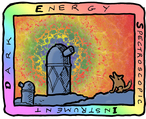| 91 | | The second panel shows the Sky brightness. The "nominal" brightness |
| 92 | | is shown by the magenta horizontal line. In this panel, the pass |
| 93 | | number of previous exposures is shown. (This corresponds to the pass |
| 94 | | we thought the image was going to be, not what the actual conditions |
| 95 | | delivered.) |
| | 91 | The second panel shows the Sky brightness relative to a nominal value. |
| | 92 | Larger values means the sky is darker than nominal. |
| | 93 | This panel also shows the pass number of previous exposures. |
| | 94 | This is the pass number of the tiles that were observed. |
| | 95 | |
| | 96 | (Note, this does *not* come from an assessment of how good the conditions were, |
| | 97 | it comes from looking at what tile we chose to observe. Note also that the "pass2.json" file |
| | 98 | may contain tiles from pass 3, so even if you have set *forcepass2*, you may see pass 3 labels |
| | 99 | in the copilot plot.) |
| 109 | | images that might not be as deep as desired. **Sometimes a line is visible in this plot (e.g. see 10hr - 11hr above 250 sec). This is the predicted max exposure time to saturate (really to get to a "do not cross" number of counts) the background. This relates to safety of the detectors. If you notice real exposure times are getting close to this line, its time to stop tonight.sh and take stock. This most easily would happen with moon and clouds which make the background high.** |
| | 113 | images that might not be as deep as desired. **Sometimes a line is visible in this plot (e.g. see 10hr - 11hr above 250 sec). This is the predicted exposure time to get 20,000 ADU from the sky background. |
| | 114 | Mosbot will try to limit the exposure times to avoid exposing for too long, but if conditions are changing rapidly, it may not realize soon enough that the sky has become too bright. The detectors can be damaged by too much light, so if you see this line, you should monitor the conditions very carefully! You may need to stop tonight.sh and take stock. This most easily happens with moon and clouds which make the background high.** |
| | 115 | |
| | 116 | The numbers on the exposure time panel are the "depth factor" of the images. A value of "1.50" indicates that we exposed for 1.5 times as long as was necessary to achieve our target depth. Note that the Mosbot does try to adapt its exposure times based on the depth achieved in other passes, so sometimes it may be shooting for depth values greater than 1.0. And when exposure times are clipped up to 80 seconds, we expect the depth factor to be greater than 1. Similarly, when exposure times are clipped down to 250 seconds, or to limit the sky background counts, then we expect the depth factor to be smaller than 1. |
| | 117 | |
